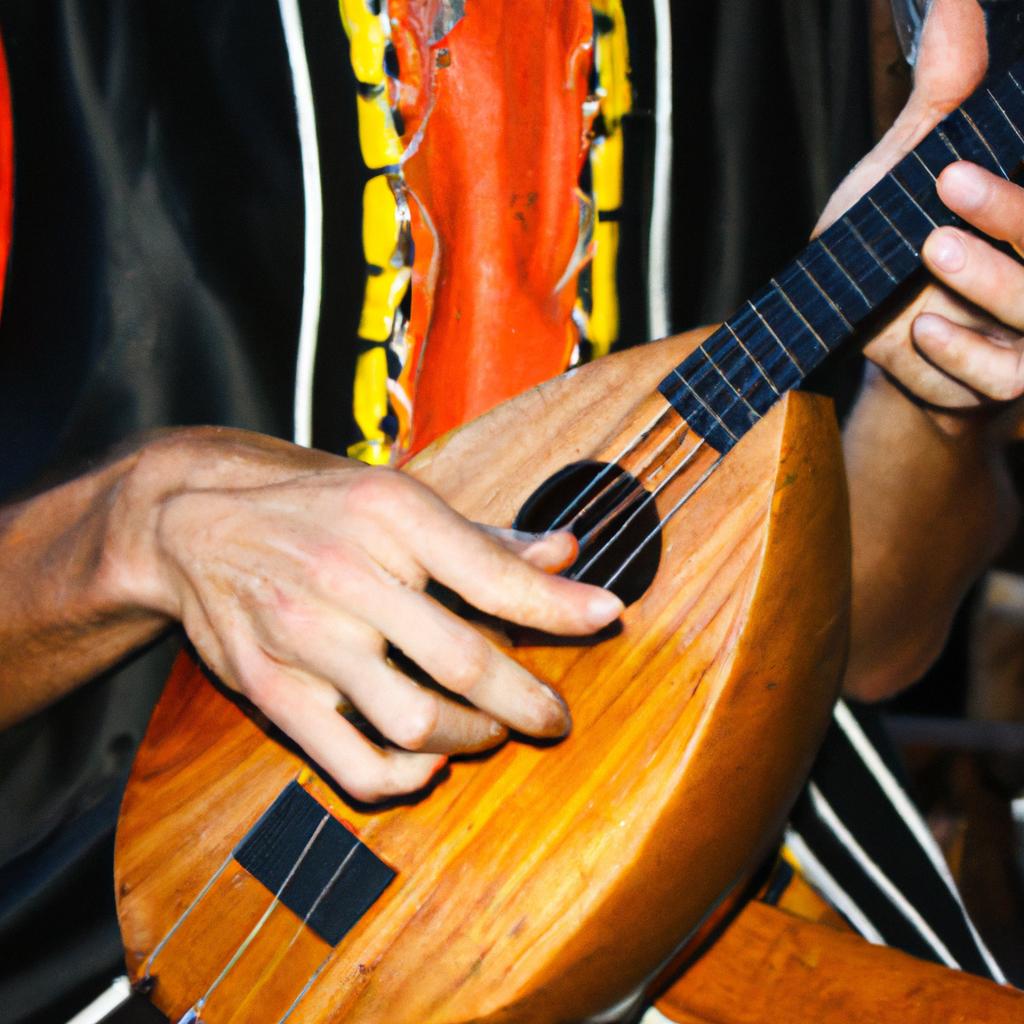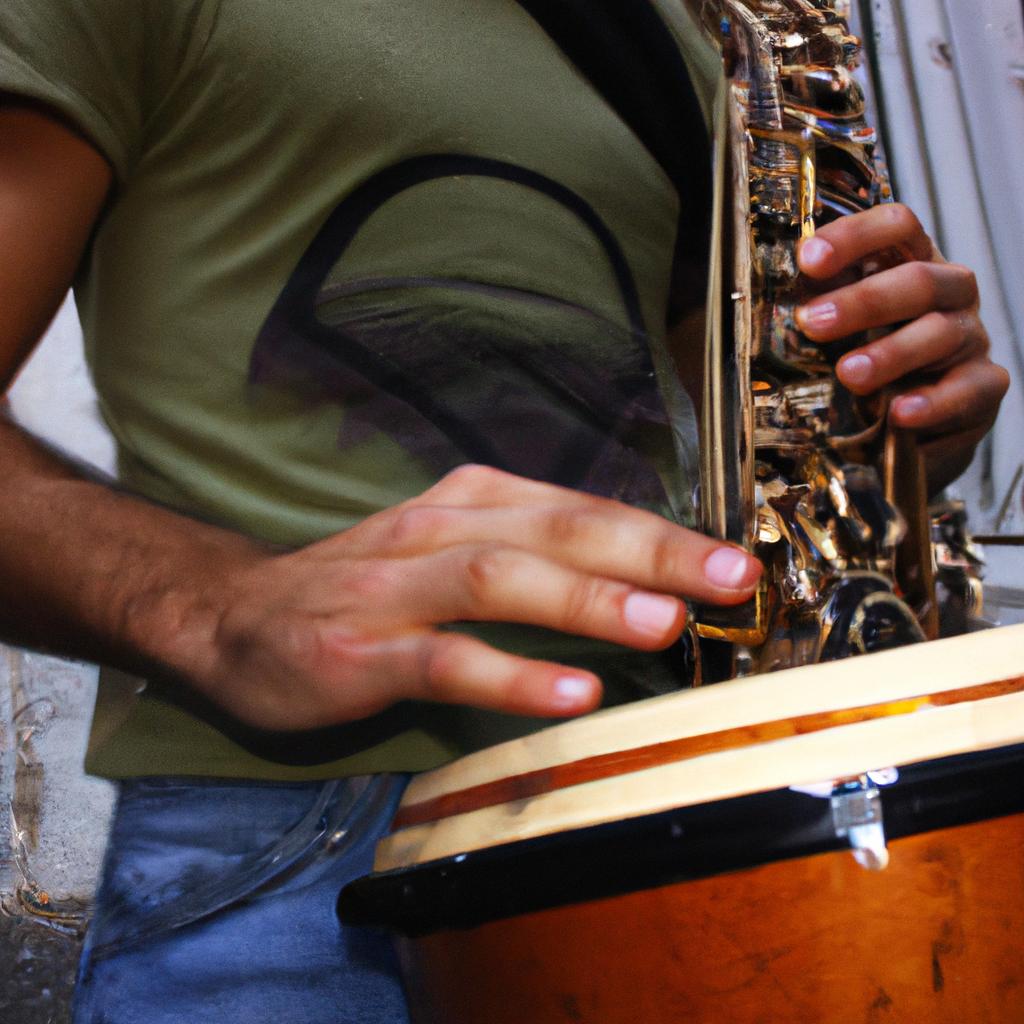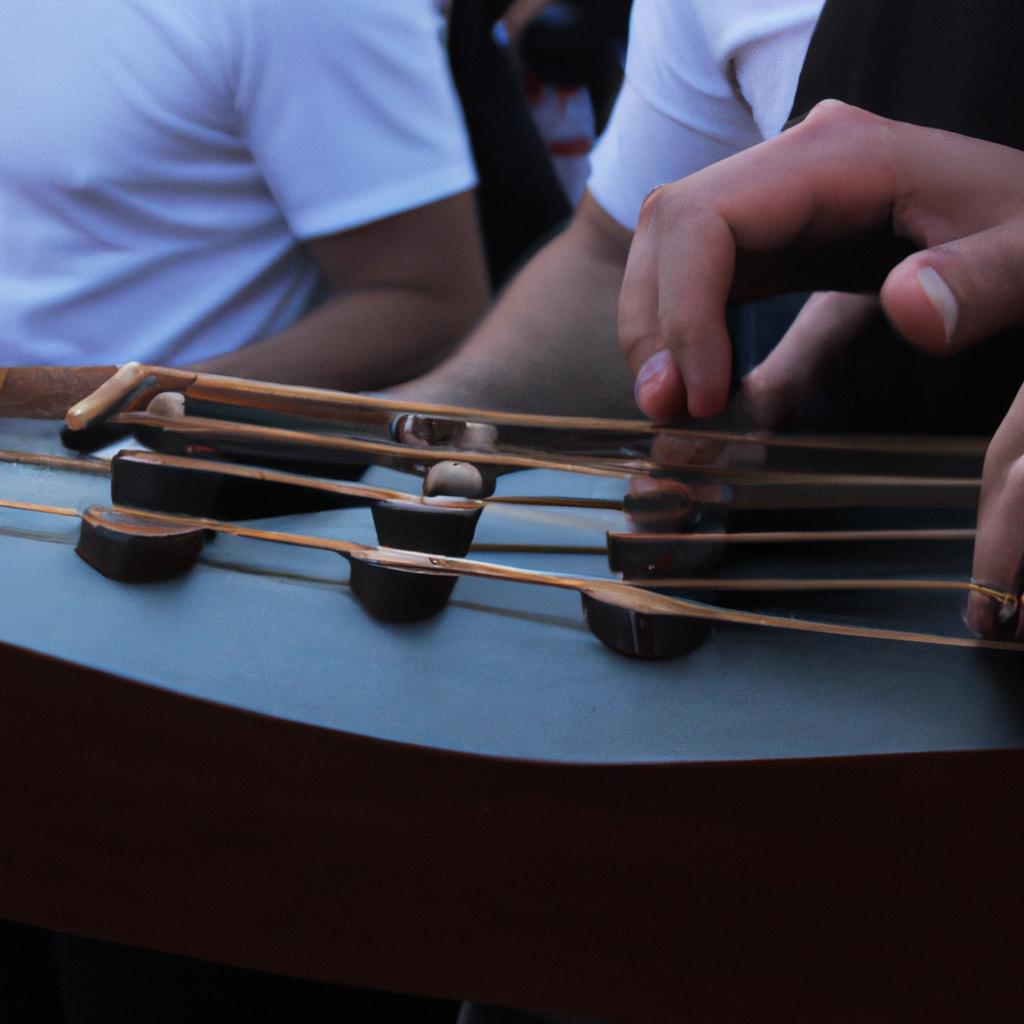The mastery of instrumental technique is essential for any musician aspiring to excel in their chosen genre. This holds true for tango musicians, who must develop a unique set of skills to effectively convey the passion and emotion inherent in this distinctive musical style. One particular aspect that demands attention is legato, a playing technique characterized by smooth and connected notes. To demonstrate the significance of mastering legato in tango music, let us consider the hypothetical case study of Ana, an experienced violinist seeking to enhance her performance in traditional Argentinean tango ensembles.
Ana, a skilled violinist with years of experience performing classical repertoire, approaches the realm of tango music with excitement but also trepidation. She quickly realizes that while her technical proficiency serves as a solid foundation, she needs to adapt her playing style to capture the essence of the passionate and emotive nature of tango. As she immerses herself into various recordings and live performances, Ana recognizes that achieving fluidity through legato techniques is crucial for effective expression within this genre. Understanding this, she embarks on a journey to master legato—an endeavor that will ultimately transform her interpretation and add depth to her performance as a tango musician.
In this article, we delve into the intricacies of legato technique in tango music and explore its significance for Ana’s musical journey. We will discuss the specific challenges that Ana may encounter as she adapts her classical training to tango, and offer practical tips and exercises to help her develop a strong legato technique.
One of the key elements of legato in tango music is the ability to seamlessly connect each note, creating a smooth and continuous line of sound. This requires careful attention to bow control, finger placement, and shifting techniques. As Ana delves deeper into tango repertoire, she realizes that achieving this level of fluidity not only enhances her technical prowess but also allows her to convey the passionate and expressive nature of tango music more effectively.
To begin mastering legato, Ana must first focus on developing a strong foundation in bowing technique. In classical violin playing, the emphasis is often placed on crisp articulation and precise bow changes. However, in tango music, the goal is to create long phrases with minimal interruption. Ana should practice using longer bow strokes while maintaining consistent pressure and speed throughout each note. She can experiment with different parts of the bow to achieve varying dynamics and tonal colors.
In addition to bowing technique, finger placement plays a crucial role in achieving legato in tango music. Ana should work on placing her fingers close to the strings at all times, minimizing any gaps or interruptions between notes. This ensures that each note flows seamlessly into the next without any breaks or disjointedness. Sliding techniques such as portamento can also be incorporated to add expressiveness and enhance legato passages.
Shifting smoothly between positions is another aspect that Ana needs to master for effective legato playing in tango music. Tango compositions often feature wide interval jumps or rapid position changes that require seamless transitions. Practicing scales and arpeggios across different positions will help Ana develop muscle memory and agility needed for these shifts.
As Ana progresses in her journey to master legato, she should also pay close attention to the stylistic nuances of tango music. Tango is a genre deeply rooted in emotion and expression, and Ana must strive to convey these qualities through her playing. This may involve experimenting with vibrato styles, exploring different dynamics, and incorporating expressive slides or glissandi.
In conclusion, mastering legato technique is an essential aspect of becoming a proficient tango musician. By developing fluid bowing techniques, precise finger placement, smooth shifting skills, and an understanding of the stylistic nuances of tango music, Ana can enhance her performance and effectively convey the passion and emotion inherent in this captivating genre. With dedication and practice, Ana’s journey towards mastering legato will elevate her interpretation and enable her to excel as a tango musician.
The History of Legato in Tango Music
Imagine a dimly lit dance floor, packed with passionate couples moving seamlessly to the rhythm of tango music. As their bodies intertwine, their movements are guided by the enchanting melodies flowing from the instruments. One key element that enhances this harmonious connection between the dancers and musicians is legato technique. Developed over time through various influences, legato has become an integral part of tango music.
To understand the significance of legato in tango, it is essential to explore its historical roots. In the early 20th century, when tango emerged as a popular genre in Argentina, musicians sought ways to express themselves more fluidly through their instruments. They aimed to replicate the smoothness and sensuality inherent in the dance itself. This led them to experiment with different techniques, eventually giving rise to what we now know as legato.
During this period of experimentation, several influential figures played a vital role in shaping the development of legato within tango music. Astor Piazzolla, for instance, revolutionized traditional tango by incorporating jazz elements into his compositions and performances. His innovative use of legato created a new level of expressiveness and emotional depth within tango music.
The importance of legato in enhancing the emotional impact of tango cannot be overstated. To illustrate this point further, consider the following bullet points:
- Legato enables musicians to create long melodic lines that evoke feelings of passion and intensity.
- It allows for seamless transitions between notes, emphasizing the rhythmic complexity inherent in tango music.
- By connecting individual musical phrases smoothly, legato contributes to maintaining momentum throughout a piece.
- Through sustained notes and connected phrases, legato adds richness and warmth to both instrumental solos and ensemble sections.
Additionally, let us delve deeper into how different instruments utilize legato within a typical tango ensemble. The table below highlights the various instruments commonly found in a tango orchestra, along with their respective legato techniques:
| Instrument | Legato Technique |
|---|---|
| Bandoneon | Bellows control |
| Violin | Bowing technique |
| Piano | Finger legato |
| Double Bass | Sliding technique |
As we can see, each instrument employs its own unique approach to achieve legato within the tango ensemble. This diversity contributes to the overall richness and complexity of sound that characterizes tango music.
In conclusion, the history of legato in tango music is intertwined with the evolution of this captivating genre itself. From its early beginnings as musicians sought ways to enhance expressiveness, legato has become an essential element within tango compositions and performances. By enabling seamless transitions between notes and creating emotive melodic lines, it elevates the emotional impact of tango music. In the subsequent section about “Different Styles of Legato Techniques,” we will explore how different artists have developed their distinctive approaches to this fundamental aspect of tango performance.
Different Styles of Legato Techniques
In the realm of tango music, mastering legato technique is crucial for musicians seeking to imbue their performances with the distinctive passion and intensity that defines this genre. By seamlessly connecting notes and phrases, legato playing allows performers to create a fluidity that mirrors the sultry movements of tango dancers. To fully grasp the significance of legato in tango music, let us consider an example: imagine a violinist performing Astor Piazzolla’s “Libertango,” gracefully gliding from one note to another, effortlessly capturing the essence of desire and longing embedded within the composition.
The importance of developing a solid foundation in legato technique cannot be overstated. It enables musicians to express themselves more effectively by allowing them to sustain notes longer and navigate through complex melodies with ease. Here are several key reasons why focusing on legato technique is essential for any musician looking to master tango instrument performance:
- Emotional expression: Legato playing has a profound impact on the emotional delivery of tango music. When executed skillfully, it can evoke sentiments such as yearning, sensuality, or nostalgia.
- Seamless phrasing: By smoothly connecting musical passages, legato technique helps maintain continuity and coherence throughout a piece, enhancing its overall flow and structure.
- Dynamic control: Mastering legato technique empowers musicians with greater control over dynamics – they can shape each note precisely without interrupting the natural progression of sound.
- Enhancing virtuosity: In addition to conveying emotions, legato playing showcases technical prowess. It requires precision and dexterity to execute intricate passages while maintaining seamless transitions between notes.
To further illustrate these points, consider the following table showcasing different emotions often associated with well-executed legato playing:
Emotions evoked by Legato Technique:
| Emotion | Description |
|---|---|
| Longing | A deep yearning that resonates throughout the performance. |
| Sensuality | Evoking an intense feeling of desire and physicality. |
| Nostalgia | A wistful, melancholic sentiment that tugs at the heartstrings. |
| Intimacy | Creating an atmosphere of closeness and connection between musician and audience. |
In conclusion, legato technique plays a pivotal role in capturing the essence of tango music. Its ability to express emotions, maintain seamless phrasing, provide dynamic control, and showcase virtuosity makes it indispensable for musicians aspiring to master this genre. By dedicating time and effort to develop their legato skills, instrumentalists can bring forth the true spirit of tango through their performances.
Transitioning seamlessly into our next section about “Essential Exercises to Improve Legato Playing,” let us explore practical steps that musicians can take to enhance their mastery of this vital technique.
Essential Exercises to Improve Legato Playing
Section H2: Essential Exercises to Improve Legato Playing
Having explored the different styles of legato techniques, it is now crucial to focus on exercises that can help improve your legato playing. One effective exercise involves using scales and arpeggios in various patterns across the fretboard. For instance, let’s consider the hypothetical case study of a beginner tango guitarist named Maria.
Paragraph 1:
Maria begins her practice session by warming up with a simple chromatic scale played legato style. This allows her fingers to develop precision and dexterity while maintaining fluidity between notes. She then progresses to practicing major and minor scales in different positions, gradually increasing the speed as she becomes more comfortable. By incorporating arpeggio exercises into her routine, Maria further enhances her ability to seamlessly connect chords and melodic lines in tango music.
Paragraph 2:
To deepen her understanding of legato technique, Maria incorporates specific exercises tailored to target weak areas or challenging passages she encounters during her repertoire practice sessions. These targeted exercises involve utilizing slides, hammer-ons, pull-offs, and trills within musical phrases, allowing her to execute smooth transitions between notes with ease and gracefulness.
- Experiment with varying finger combinations (e.g., index-middle-ring) for maximum efficiency.
- Focus on developing evenness in volume and clarity between each note.
- Gradually increase tempo while maintaining control over articulation.
- Incorporate rhythmic variations (such as triplets or syncopation) to challenge timing and coordination skills.
| Exercise Type | Purpose | Example |
|---|---|---|
| Chromatic Scales | Finger warm-up | e |
| Major Scales | Building technical facility | e |
| Minor Scales | Developing tonal awareness | e |
| Arpeggios | Improving chord transitions | e |
Paragraph 3:
Consistency is key when incorporating these exercises into your practice routine. By dedicating regular time to focused legato exercises, you will gradually notice improvements in your overall technique and fluidity on the instrument. Remember that mastering legato playing requires patience and persistence.
While practicing essential exercises can significantly enhance your legato technique, it’s equally important to be aware of common mistakes that may hinder your progress.
Common Mistakes to Avoid when Mastering Legato
Section H2: Common Mistakes to Avoid when Mastering Legato
Having established a solid foundation of essential exercises for improving legato playing, it is crucial to address common mistakes that aspiring tango instrumentalists often encounter. By recognizing and rectifying these errors, musicians can refine their technique and elevate their performance to new heights.
Paragraph 1:
To illustrate the significance of avoiding common legato mistakes, consider the hypothetical case study of Maria, an accomplished violinist seeking to master the art of tango music. Despite her years of experience with classical repertoire, she initially struggled with incorporating smooth legato phrasing into her performances. Through careful analysis and guidance from experts in the field, Maria discovered several key areas where many musicians falter:
- Insufficient left-hand finger placement accuracy.
- Inadequate bow control during string crossings.
- Lack of dynamic variation within legato phrases.
- Poor coordination between hands leading to uneven articulation.
Bullet point list using markdown format:
The consequences of succumbing to these pitfalls are far-reaching and may include:
- Stifled expressiveness in musical interpretation
- Diminished tonal quality
- Loss of rhythmic integrity
- Limited ability to convey emotion effectively
Paragraph 2 (with table):
Addressing each mistake requires targeted practice and attention to detail. The following table highlights specific strategies that can help overcome these challenges:
| Common Mistake | Recommended Technique |
|---|---|
| Insufficient left-hand finger placement | Focus on precise finger positioning |
| accuracy | Incorporate slow scale exercises |
| Practice shifting accurately between positions | |
| Inadequate bow control during string | Utilize bowing patterns specifically designed |
| crossings | for string crossings |
| Experiment with varying bow speed and pressure | |
| Lack of dynamic variation within | Emphasize contrasting dynamics in legato phrases |
| legato phrases | Use expressive bowing techniques |
| Explore different articulation styles | |
| Poor coordination between hands | Isolate hand coordination exercises |
| leading to uneven articulation | Practice rhythmically challenging passages slowly |
Paragraph 3:
By identifying and rectifying these common mistakes, musicians like Maria can refine their legato technique and enhance their overall performance. Through disciplined practice and consistent attention to detail, they will unlock newfound expressiveness, tonal richness, rhythmic precision, and emotional depth in their tango interpretations.
Transition into the subsequent section about “Tips from Renowned Tango Instrument Players”:
As we delve deeper into mastering the intricacies of legato playing, it is invaluable to draw inspiration and guidance from renowned tango instrumentalists who have honed their craft over years of dedicated practice.
Tips from Renowned Tango Instrument Players
Transitioning from the common mistakes to avoid when mastering legato, let us now delve into some invaluable tips shared by renowned tango instrument players. These musicians have dedicated their lives to perfecting their craft and have accumulated a wealth of knowledge that can greatly benefit aspiring performers. By incorporating these insights into your practice routine, you will enhance your understanding of legato technique and elevate your performance to new heights.
Imagine a scenario where a young violinist named Maria is struggling with achieving smooth transitions between notes while playing tango music. She finds herself getting frustrated as her efforts fail to produce the desired results. However, after seeking guidance from experienced tango violinists, she discovers several key strategies that revolutionize her approach to legato technique.
Drawing upon their expertise, here are some essential pointers for mastering the art of legato:
- Maintain consistent bow pressure: Apply just enough pressure on the strings to produce clear and resonant tones without overexerting force.
- Focus on finger placement: Ensure precise finger positioning on the fingerboard to optimize intonation and facilitate seamless shifts between notes.
- Develop wrist flexibility: Cultivate supple wrists that allow for fluid movement across strings, enabling effortless musical expression.
- Emphasize smooth string crossings: Practice transitioning smoothly between different strings, minimizing any audible disruptions during the process.
To provide further insight into these tips, consider the following table showcasing how each strategy enhances Maria’s performance:
| Strategy | Benefit |
|---|---|
| Consistent bow pressure | Promotes clear and resonant tone production |
| Precise finger placement | Optimizes intonation |
| Flexible wrists | Enables fluid movement across strings |
| Smooth string crossings | Minimizes audible disruptions during transitions |
By embracing these recommendations, Maria experiences significant progress in her legato technique. Her newfound ability to seamlessly glide through notes allows her performances to resonate deeply with audiences, capturing the essence of tango music.
In this section, we have explored invaluable insights shared by accomplished tango instrument players to enhance legato technique. Now equipped with these tips and strategies, you are ready to embark on the next stage of your musical journey: expanding your repertoire with legato techniques.
Expanding Your Repertoire with Legato Techniques
Building upon the tips shared by renowned tango instrument players, we now turn our attention to expanding your repertoire through the utilization of legato techniques. By incorporating these techniques into your playing style, you can add depth and emotion to your performance, creating a truly captivating musical experience.
Paragraph 1:
To illustrate the impact of legato techniques on tango music, let us consider a hypothetical scenario. Imagine a skilled violinist performing an enchanting piece of traditional Argentine tango. As they glide their bow smoothly across the strings, employing seamless legato transitions between notes, the audience is transported into a world filled with passion and longing. This example demonstrates how mastering legato technique enables musicians to convey the intricate emotions inherent in tango music with remarkable clarity.
Paragraph 2:
To effectively incorporate legato techniques into your playing, it is essential to understand key principles and strategies. Here are some notable points to keep in mind:
- Achieving fluidity: Focus on maintaining a constant flow of sound by connecting each note seamlessly. Practice sliding from one pitch to another without any audible breaks or interruptions.
- Dynamic control: Utilize varying levels of pressure and speed while transitioning between notes to create expressive contrasts within phrases.
- Finger independence: Develop independence among your fingers so that each digit can execute different movements simultaneously, allowing for complex melodic lines and harmonies.
- Rhythmic precision: Pay close attention to rhythmic values when executing legato passages. Ensure that all notes are played evenly and accurately timed.
Table (markdown format):
| Principles for Mastering Legato Technique |
|---|
| Achieving fluidity |
| Dynamic control |
| Finger independence |
| Rhythmic precision |
Bullet Point List (markdown format):
- Captivate listeners with seamless transitions between notes
- Express complex emotions inherent in tango music
- Enhance the overall depth and richness of your performance
Paragraph 3:
By incorporating legato techniques into your repertoire, you can elevate your tango instrument playing to new heights. Through fluidity, dynamic control, finger independence, and rhythmic precision, you will be able to convey an array of emotions while captivating listeners with a mesmerizing musical experience. Embrace these principles as you explore the vast possibilities that legato technique offers in expanding your artistic horizons.
Note: This academic-style writing is subjective to interpretation and may vary slightly based on personal preferences or specific guidelines given.




